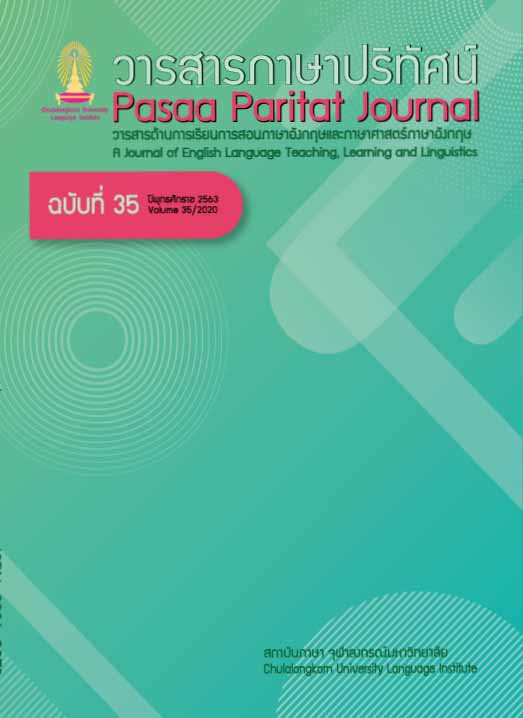Word Formation Processes in Thai Outdoor Advertisements
Keywords:
word information, lexical analysis, outdoor advertisementAbstract
The purpose of this study is to analyze word formation process in outdoor advertisements found on the main roads and in the department stores in Bangkok. The study finds 36 outdoor advertisements which include 39 new words created and 53 samples of word formation process categories. The results of the study represents that slogan and brand name in particular goods such as clothes, vehicles, and shoes are most frequently discovered in those outdoor advertisements. The study indicates that 37.74 percent of those new words are created by compounding which is the most frequently used of word formation processes in outdoor advertisements. The second frequently used is 13.21 percent of new words created by multiple processes, following by 7.55 percent of new words created by blending, and loanword, then, 5.66 percent of new words created by derivation or affixation, clipping,
and conversion. And 3.77 percent of new words created by Back-formation and Acronyms, finally, 1.89 percent of new words created by creative respelling and inflection, respectively. Furthermore, the study also catches 5.66 percent of new words created by other processes like using idioms and sentences. However, calques or loan translation does not invent in outdoor advertisements in this study.
References
การวิเคราะห์สื่อ. (27 มิถุนายน 2560). http://www.slideshare.net/rainacid/ss-4929282
การสร้างคำ (Word Formation) (27 มิถุนายน 2560). http://th.wikipedia.org
ปิยานุช พู่เกล้า และ นภาศรี ทิมแย้ม. (2555). Word Formation Processes of Neologisms Found in Women Cosmetic Advertisement in Women
Magazines. วารสารมนุษยศาสตร์วิชาการ. 19(1), 197-214.
ภัทรินทร์ ทยะราษฎร์. (2551). การศึกษาการสร้างคาและกลวิธีการเขียนข้อความพาดหัวโฆษณาในนิตยสารผู้หญิง. วารสารภาษาไทยและวัฒนธรรมไทย. 2(3), 94-108.
รุ่งนภา พิตรปรีชา. (2547). “องค์ประกอบของการโฆษณา” ใน เอกสารการสอนชุดวิชาหลักการโฆษณาและประชาสัมพันธ์ หน่วยที่ 1-7. (พิมพ์ครั้งที่ 7). นนทบุรี:
มหาวิทยาลัยสุโขทัยธรรมาธิราช.
รุ่งรัตน์ ชัยสาเร็จ. (2557). การเขียนเพื่อการประชาสัมพันธ์. กรุงเทพฯ: จุฬาลงกรณ์มหาวิทยาลัย.
วงหทัย ตันชีวะวงศ์. (2554). การโฆษณาข้ามวัฒนธรรม. กรุงเทพฯ: มหาวิทยาลัยธรรมศาสตร์.
วรวุฒิ ภักดีบุรุษ. (2552). ศิลปะการใช้ภาษาเพื่องานนิเทศศาสตร์. กรุงเทพฯ: ทริปเพิ้ลเอ็ดดูเคชั่น.
สื่อโฆษณา. (27 มิถุนายน 2560) http://th.wikipedia.org
อมรา ประสิทธิ์รัฐสิทธ์. (2541). ภาษาศาสตร์สังคม. กรุงเทพฯ: จุฬาลงกรณ์มหาวิทยาลัย.
อวยพร พานิช. (2526). เอกสารการสอนชุดวิชาการสร้างสรรค์และผลิตสิ่งโฆษณา หน่วยที่ 1-8. นนทบุรี: มหาวิทยาลัยสุโขทัยธรรมาธิราช.
Aitchison, J. (1994). Words in the Mind: An Introduction to the Mental Lexicon. (2nd ed.) New York: Blackwell.
Anggraeni, D. (2011). Word formation process in outdoor advertisement. Master's degree Thesis. Diponegoro University, Semarang.
Bivins, T. H. (2008). Public Relations writing: the essentials of style and format. (6th ed.) Boston Burr Ridge, IL: McGraw Hill.
Huddleston, R. et al. (2002). The Cambridge Grammar of the English Language. Cambridge: Cambridge Univ. Pr.
Kemmer, S. (2011). Types of Word Formation Processes. http://www.ruf.rice.edu/~kemmer/Words/wordtypes.html
Mustafa, S. Z. B., Kandasamy, M. D/O, & Yasin, M. S. M. (2015). An analysis of word formation process in everyday communication on Facebook. International Journal of Education and Research. 3(6), 261-274.
Nordquist, R. (2010). Word-formation. http://grammar.about.com/od/tz/g/Word-Formation.htm On July 11,
Plag, I. (2003). Word-Formation in English. Cambridge: Cambridge Univ. Pr.
Trigwell-Jones, M. (2010). Commerce. Cambridge: Cambridge Univ. Pr.
Vörös, T. (2010). Creativity in Advertising Slogans Based On Word-Formation. Bachelor paper. University of Pardubice.
Yule, G. (2006). The Study of Language. (3rd ed.) Cambridge: Cambridge Univ. Pr.
Downloads
Published
How to Cite
Issue
Section
License

This work is licensed under a Creative Commons Attribution-NonCommercial-NoDerivatives 4.0 International License.



